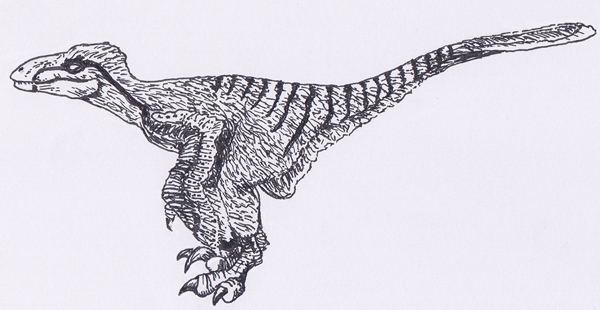The Speedy Dromaeosaurs – Data on Dinosaur Movement
There are two main types of fossil – trace fossils and body fossils. Body fossils, as the name suggests preserve something of the bodily remains of organisms. Typical body fossils consist of bones, shells, eggs, leaves and such like, or their impressions in the encasing sediment. Trace fossils are distinct from body fossils as they preserve evidence of the activity of the organism.
Typical trace fossils are borings, burrows, trails and of course foot prints. An individual dinosaur footprint can provide a considerable amount of information to an ichnologist (a scientist specialising in the study of footprints and tracks), however, much more data can be obtained if a set of prints, a trackway of an animal is preserved. Although it can be difficult to associate a particular genus or even a family to a set of prints (unless of course the maker of the prints is found preserved as a fossil at the end of the tracks), scientists can tell a lot about the movement of the animal, even an estimate of the speed of travel can be made.
Ichnologists at Work
An example of the work of icnologists and their contribution to our knowledge of dinosaurs has just been published in the scientific journal “Palaeogeography, Palaeoclimatology, Palaeoecology”. A team of American scientists have been studying the fossil trackway left by a small theropod dinosaur, in South Korea, they have concluded that this little animal was trotting along at approximately 18 kmh, about as fast as a professional footballer can run.
Picture credit: Everything Dinosaur
The Beasts of the Mesozoic range of articulated models contains numerous dromaeosaurid replicas: Beasts of the Mesozoic Models.
The trackway studied consists of a series of prints made by a two-toed dinosaur. This type of print is characteristic of a dromaeosaur, a small group of bipedal, active meat-eating dinosaurs such as Velociraptor and Deinonychus. This little carnivore, estimated to be around 65 cm high at the hips, was moving in a straight line, parallel to a lake. Although the genus cannot be identified, scientists are confident that this is a dromaeosaur as the big-toe on the three-toed hind foot, would be held off the ground to protect its sickle claw as the animal ran. It is apt that the trackway was made by a dromaeosaur, as this word derived from the Greek means “running dinosaurs”.
More information on Korean dinosaur footprints can be found here: Two-toed Dinosaur Footprint found in Korea – Dromaeosaurs in Korea.
The trackway has been found in the Haman Formation in South Korea, the tracks consist of 14 cm prints, two toes per print with each digit have four concentric pads terminating in a sharp, prominent claw.
“This strongly curved and sharp claw was held off the ground surface in normal locomotory situations in order to prevent the ungual (the claw bone, the distal-most phalanx of a digit) from becoming dull with repeated contact against an abrasive substrate, strongly suggesting that it had an offensive function, such as attacking prey”, commented one of the research team members.
Mathematical Formula
Using a mathematical formula developed in the 1970s scientists are able to speculate that the height of the animal at the hips would be approximately 5 times the footprint length. With this formula (developed by Alexander (1976)), the speed of the animal can be determined by measuring the hip height and the length of the stride. The American team who have published the paper on the footprints, estimate that this little dinosaur was moving at around 18 kmh. Other studies, based on comparative studies with extant animals (animals living today) and computer models indicate that these dromaeosaurs were capable of running at much faster speeds.
A team of scientists from Manchester University used modelling techniques to compare the maximum running speeds of several types of dinosaurs with emus, ostriches and other extant animals and birds. In their report, Velociraptor (a typical dromaeosaur) was estimated to have a top speed of nearly 40 kmh. Perhaps the footprints in Korea represent one of these dinosaurs trotting along.
To read more about the Manchester team’s work: So Tyrannosaurus rex could run down David Beckham.







Leave A Comment